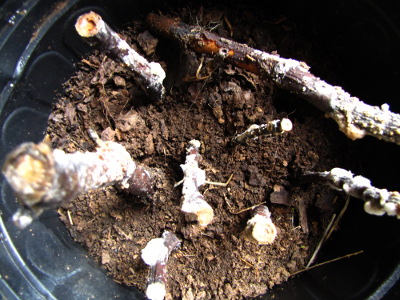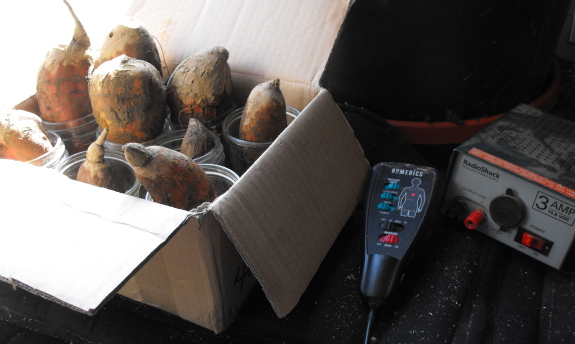
Ten tips for successful rooting

Want to increase your
success rate rooting cuttings? Try out these ten tips.
1.
Pay attention to time of day and time of year. As I mentioned in a
previous post, softwood,
greenwood, and hardwood cuttings are all taken at different times of
year, and different
plant species respond better to different seasons. If you're
taking softwood or greenwood cuttings, it's best to actually cut the
stems early in the morning when they're full of water and the air is
cool to minimize wilting.
2.
Skip the tips and blooms. The actively growing
tips of twigs usually have less stored carbohydrates, meaning that they
don't have as much food to draw on before they root and start
photosynthesizing again. Similarly, parts of trees that have
flower buds are going to be putting their energy elsewhere, so it's
best to choose areas that aren't flowering this year.
 3. Stick
to the young.
Within the same tree or bush, certain parts of the plant act younger
than others. The so-called cone of juvenility shows the parts of
a tree that are the least mature biologically and most likely to root
easily. If you're trying to propagate lots of plants effectively,
it can be worth coppicing the parent plant so that it keeps putting out
new growth from within the cone. And even if you're selecting
cuttings from a mature tree, you can try to get more youthful
twigs by finding sprouts low and near the trunk.
3. Stick
to the young.
Within the same tree or bush, certain parts of the plant act younger
than others. The so-called cone of juvenility shows the parts of
a tree that are the least mature biologically and most likely to root
easily. If you're trying to propagate lots of plants effectively,
it can be worth coppicing the parent plant so that it keeps putting out
new growth from within the cone. And even if you're selecting
cuttings from a mature tree, you can try to get more youthful
twigs by finding sprouts low and near the trunk.
4.
Choose a good rooting medium. As long as it's fluffy
and able to hold a lot of water, most rooting mediums work pretty
well. Options include sand, peat, perlite, pine bark,
pumice, or sandy soil (and I generally use stump
dirt).
Remember that your plants don't need much fertility in their rooting
medium, although you will probably want to add some kind of fertilizer
once they're well rooted and are putting out new leaves.
 5. Rooting hormones and
fungicides can help. I wrote a whole post
about rooting
hormones, some of
which include anti-fungicidal agents. I learned the hard way that
cuttings can be the perfect habitat for fungi, but I also suspect that
if you do everything else right, you might not need the chemical aids.
5. Rooting hormones and
fungicides can help. I wrote a whole post
about rooting
hormones, some of
which include anti-fungicidal agents. I learned the hard way that
cuttings can be the perfect habitat for fungi, but I also suspect that
if you do everything else right, you might not need the chemical aids.
6.
Wounding isn't always bad. Difficult-to-root
greenwood and hardwood cuttings are sometimes wounded near the base to
promote rooting. Wounding usually consists of scarring the bark
(but not the green cambium underneath) for half to one inch of the
base. Similarly, girdling can be used as a preconditioning step
for
rooting since it concentrates carbohydrates and hormones in small area,
which will make roots form better there.
7.
Keep cuttings moist but not wet. Softwood and greenwood
cuttings, especially, can dry out by losing too much water through
their leaves before they root. Steps as simple as partial shade
or a plastic bag over top of the pot can work, as can more complicated
misting setups used in nurseries. However, be aware that too much
moisture can be a problem, especially in the slower-growing hardwood
cuttings.
 8. Some like it hot. Bottom heat can help
cuttings root...or it can prompt them to grow leaves, use up their
reserves too quickly, and perish. The most common use of heat is
beneath cuttings started outdoors in the winter. Next most common
is using heat to callus hardwood cuttings, which helps precondition
them for rooting. To callus cuttings, apply bottom heat for four
weeks, place in
plastic bag in
the dark at 50 degrees Fahrenheit, bury upside down in soil, sand, or
sawdust, or store in a warm, moist place for three to five
weeks. As you can tell from the various methods, it's probably
best to look up the species you're considering rooting before deciding
whether and how to callus.
8. Some like it hot. Bottom heat can help
cuttings root...or it can prompt them to grow leaves, use up their
reserves too quickly, and perish. The most common use of heat is
beneath cuttings started outdoors in the winter. Next most common
is using heat to callus hardwood cuttings, which helps precondition
them for rooting. To callus cuttings, apply bottom heat for four
weeks, place in
plastic bag in
the dark at 50 degrees Fahrenheit, bury upside down in soil, sand, or
sawdust, or store in a warm, moist place for three to five
weeks. As you can tell from the various methods, it's probably
best to look up the species you're considering rooting before deciding
whether and how to callus.
9.
Don't rush them out of the nursery. Softwood cuttings,
especially, often benefit from spending two years being babied before
being planted in their final location. And a few cuttings even
need supplemental light in the fall to prompt them to put out a growth
spurt and store enough energy to make it through the winter. If
you're going to go to all the trouble of rooting cuttings, don't let
them die on you after the roots form.
10.
Keep notes.
So many variables can affect the success or failure of your cuttings
that it's essential to write everything down so you can make changes
and try again. And don't feel bad if the techniques that work for
someone else don't work for you. Some varieties within the same
species root better than others, so you might not even be on an even
playing field.
| This post is part of our Reference Manual of Woody Plant Propagation
lunchtime series.
Read all of the entries: |
Want more in-depth information? Browse through our books.
Or explore more posts by date or by subject.
About us: Anna Hess and Mark Hamilton spent over a decade living self-sufficiently in the mountains of Virginia before moving north to start over from scratch in the foothills of Ohio. They've experimented with permaculture, no-till gardening, trailersteading, home-based microbusinesses and much more, writing about their adventures in both blogs and books.
Want to be notified when new comments are posted on this page? Click on the RSS button after you add a comment to subscribe to the comment feed, or simply check the box beside "email replies to me" while writing your comment.
- Remove comment
